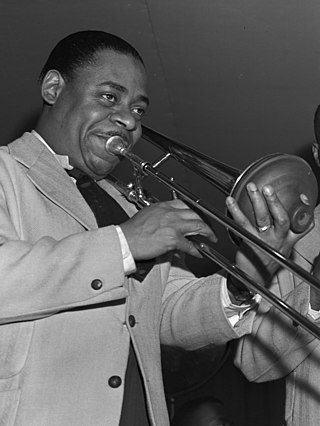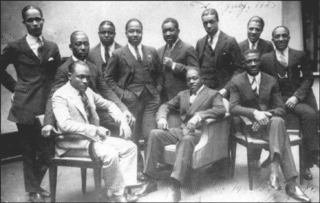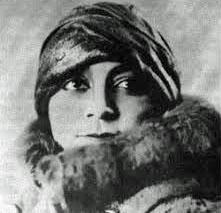Related Research Articles
Wah-wah is an imitative word for the sound of altering the resonance of musical notes to extend expressiveness, sounding much like a human voice saying the syllable wah. The wah-wah effect is a spectral glide, a "modification of the vowel quality of a tone".

Coleman Randolph Hawkins, nicknamed "Hawk" and sometimes "Bean", was an American jazz tenor saxophonist. One of the first prominent jazz musicians on his instrument, as Joachim E. Berendt explained: "there were some tenor players before him, but the instrument was not an acknowledged jazz horn". Hawkins biographer John Chilton described the prevalent styles of tenor saxophone solos prior to Hawkins as "mooing" and "rubbery belches". Hawkins denied being first and noted his contemporaries Happy Caldwell, Stump Evans, and Prince Robinson, although he was the first to tailor his method of improvisation to the saxophone rather than imitate the techniques of the clarinet. Hawkins' virtuosic, arpeggiated approach to improvisation, with his characteristic rich, emotional, and vibrato-laden tonal style, was the main influence on a generation of tenor players that included Chu Berry, Charlie Barnet, Tex Beneke, Ben Webster, Vido Musso, Herschel Evans, Buddy Tate, and Don Byas, and through them the later tenormen, Arnett Cobb, Illinois Jacquet, Flip Phillips, Ike Quebec, Al Sears, Paul Gonsalves, and Lucky Thompson. While Hawkins became known with swing music during the big band era, he had a role in the development of bebop in the 1940s.

Mamie Smith was an American singer. As a vaudeville singer, she performed in multiple styles, including jazz and blues. In 1920, she entered blues history as the first African-American artist to make vocal blues recordings. Willie "The Lion" Smith described the background of these recordings in his autobiography Music on My Mind (1964).
James Wesley "Bubber" Miley was an American early jazz trumpet and cornet player, specializing in the use of the plunger mute.

Joe "Tricky Sam" Nanton was an American trombonist with the Duke Ellington Orchestra. A pioneer of the plunger mute, Nanton is notable for his use of the distinctive wah-wah effect.

Garvin Bushell(néGarvin Lamont Payne; September 25, 1902 – October 31, 1991) was an American clarinetist, saxophonist, and bassoonist. He performed with many prominent 20th-century jazz musicians, including Jelly Roll Morton and John Coltrane.
George "Little Mitch" Mitchell was an American jazz cornet player active in the 1920s.
VOX Schallplatten- und Sprechmaschinen-Aktiengesellschaft, Berlin was a German record label founded in 1921. One source suggests that it issued the first electrical recordings in Germany in late 1924 or early 1925, presumably recorded by a method other than that of Western Electric, but notes that it did not generally adopt electric recording technology until some 18 months later.
Carroll Dickerson was a Chicago and New York–based dixieland jazz violinist and bandleader, probably better known for his extensive work with Louis Armstrong and Earl Hines or his more brief work touring with King Oliver.
Samuel David Wooding was an American jazz pianist, arranger and bandleader living and performing in Europe and the United States.

Perry Bradford was an American composer, songwriter, and vaudeville performer. His most notable songs included "Crazy Blues," "That Thing Called Love," and "You Can't Keep A Good Man Down." He was nicknamed "Mule" because of his stubbornness, and he is credited with finally persuading Okeh Records to work with Mamie Smith leading to her historic blues recording in 1920.

Lena Wilson was an American blues singer who performed in the classic female blues style. An African-American, Wilson performed in vaudeville with her brother Danny and his wife, Edith Wilson in the late 1910s and 1920s. Wilson made numerous recordings in the 1920s as a solo artist, for labels such as Black Swan, Paramount, Pathé, Victor, and Vocalion.
Herb Flemming was an American jazz trombonist and vocalist who played extensively in Europe.
Charles Edward Dixon was an American jazz banjoist.

Edith Wilson was an American blues singer, vaudeville performer, and actress from Louisville, Kentucky, U.S. An African-American who performed and recorded in the classic female blues style in the 1920s, Wilson worked in vaudeville and stage productions, first in Louisville and later throughout the U.S. and abroad. From the 1930s onward, she acted in radio plays and television, and from 1948 to 1966 represented the Aunt Jemima brand for Quaker Oats in personal appearances and on television. She remained an active performer until 1980.
Everett "Happy" Robbins was a Chicago-based pianist, bandleader and composer.

Lillyn Brown, sometimes credited as Lillyan Brown, was an American singer, vaudeville entertainer and teacher who claimed to have been "the first professional vocalist to sing the blues in front of the public", in 1908. She was billed as "The Kate Smith of Harlem" and "The Original Gay 90's Gal".
The Nest Club was a cabaret in Harlem, more specifically an afterhours club, at 169 West 133rd Street – a street known then both as "Swing Street" and "Jungle Alley" – two doors east of Seventh Avenue, downstairs. The club, operating under the auspices of The Nest Club, Inc., was founded in 1923, co-owned, and operated by John C. Carey (né John Clifford Carey; 1889–1956) and Mal Frazier (né Melville Hunter Frazier; 1888–1967). The club flourished through 1933. The U.S. Prohibition — a nationwide ban on the sale of alcoholic beverages — ran from 1920 to 1933. The club faced a formidable challenge to its viability following the Great Crash of October 1929, followed by the Great Depression that bottomed around March 1933.
The Chocolate Kiddies is a three-act Broadway-styled revue that, in its inaugural production – from May to September 1925 – toured Berlin, Hamburg, Stockholm, and Copenhagen. The show never actually performed on Broadway, but was conceived, assembled, and rehearsed there. Chocolate Kiddies commissioned new works, but was also an amalgamation and adaptation of several leading African American acts in New York, specifically Harlem, intended to showcase exemplary jazz and African American artistry of the Harlem Renaissance. Early jazz was uniquely American; and, while New Orleans enjoys popularity for being its birthplace, the jazz emerging from Harlem during the Renaissance had, on its own merits, captured international intrigue.
References
- 1 2 3 "Biography by Scott Yanow". AllMusic . Retrieved September 2, 2011.
- ↑ Carr, Ian; Digby Fairweather; Brian Priestley (1995). Jazz: The Rough Guide. The Rough Guides. pp. 183. ISBN 1-85828-137-7.
- ↑ Giles Oakley (1997). The Devil's Music. Da Capo Press. p. 84. ISBN 978-0-306-80743-5.
- ↑ Black Recording Artists, 1877-1926: An Annotated Discography. McFarland. December 12, 2012. p. 404. ISBN 9780786472383 – via Google Books.
- ↑ "Johnny Dunn". Red Hot Jazz Archive. 29 August 2020. Retrieved 29 August 2020.
- ↑ "Johnny Dunn's Original Jazz Hounds". Red Hot Jazz Archive. September 2020. Retrieved 1 September 2020.
- ↑ "Johnny Dunn and his Jazz Band". Red Hot Jazz Archive. September 2020. Retrieved 1 September 2020.
- ↑ "Johnny Dunn and his Original Jazz Band". Red Hot Jazz Archive. September 2020. Retrieved 1 September 2020.
- ↑ "Edith Wilson and Johnny Dunn's Jazz Hounds". Red Hot Jazz Archive. September 2020. Retrieved 1 September 2020.
- ↑ "Johnny Dunn and his Band". Red Hot Jazz Archive. September 2020. Retrieved 1 September 2020.
- ↑ "Tricky Sam Nanton @ All About Jazz". Musicians.allaboutjazz.com. Retrieved 25 July 2019.
- ↑ Brothers, Thomas (2014). Louis Armstrong: Master of Modernism. New York, NY: W.W. Norton & Company. pp. 258–59. ISBN 978-0-393-06582-4.